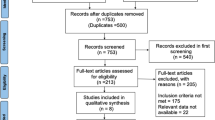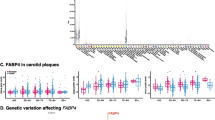Abstract
There are limited and controversial data regarding the impact of 4G/5G polymorphism of the plasminogen activator inhibitor-1 (PAI-1) gene in the pathogenesis of premature myocardial infarction (MI). We explored whether 4G/5G polymorphism of the PAI-1 gene is associated with the development of MI ≤ 35 years of age. We recruited 201 consecutive patients who had survived their first acute MI ≤ 35 years of age (mean age = 32.2 ± 3.4 years). The control group consisted of 140 healthy individuals matched with cases for age and sex, without a family history of premature coronary heart disease. 4G/5G polymorphism of PAI-1 was tested with polymerase chain reaction and reverse hybridization. 4G allele carriers (4G/4G and 4G/5G genotypes) of PAI-1 were less frequent in patients than in controls (69.6 vs. 83.6%, P = 0.007). 4G carriership of the polymorphism of PAI-1 was associated with lower risk for acute MI (odds ratio 0.45, 95% confidence interval 0.23–0.88, P = 0.02) after adjusting for major cardiovascular risk factors. Patients possessing the 4G allele had higher PAI-1 plasma levels (32.2 ± 25 vs. 22.2 ± 11.3 ng/ml, P = 0.006) but lower lipoprotein(a) levels (10.1 [2.1–29.9] vs. 15.3 [8.2–57.1] mg/dl, P = 0.03) compared to 5G/5G homozygotes. Our data indicate that the 4G allele of the PAI-1 4G/5G polymorphism is less frequent among survivors of MI at very young age compared with matched controls.
Similar content being viewed by others
References
Voetsch B, Loscalzo J (2004) Genetic determinants of arterial thrombosis. Arterioscler Thromb Vasc Biol 24:216–229
Zimmerman FH, Cameron A, Fisher LD, Ng G (1995) Myocardial infarction in young adults: angiographic characterization, risk factors and prognosis (Coronary Artery Surgery Study Registry). J Am Coll Cardiol 26:654–661
Glueck CJ, Munjal J, Aregawi D, Agloria M, Winiarska M, Khalil Q, Wang P (2007) Thrombophilia-hypofibrinolysis and atherothrombotic cardiovascular disease ≤ age 45 years. Transl Res 150:93–100
Ardissino D, Mannucci PM, Merlini PA, Duca F, Fetiveau R, Tagliabue L, Tubaro M, Galvani M, Ottani F, Ferrario M, Corral J, Margaglione M (1999) Prothrombotic genetic risk factors in young survivors of myocardial infarction. Blood 94:46–51
Rallidis LS, Belesi CI, Manioudaki HS, Chatziioakimidis VK, Fakitsa VC, Sinos LE, Laoutaris NP, Apostolou TS (2003) Myocardial infarction under the age of 36: prevalence of thrombophilic disorders. Thromb Haemost 90:272–278
Hamsten A, de Faire U, Walldius G, Dahlén G, Szamosi A, Landou C, Blombäck M, Wiman B (1987) Plasminogen activator inhibitor in plasma: risk factor for recurrent myocardial infarction. Lancet 2:3–9
Kohler HP, Grant PJ (2000) Plasminogen-activator inhibitor type 1 and coronary artery disease. N Engl J Med 342:1792–1801
Vaughan DE, PAI-1, atherothrombosis (2005) J Thromb Haemost 3:1879–1883
van Hinsbergh VW, Kooistra T, van den Berg EA, Princen HM, Fiers W, Emeis JJ (1988) Tumor necrosis factor increases the production of plasminogen activator inhibitor in human endothelial cells in vitro and in rats in vivo. Blood 72:1467–1473
Brogren H, Karlsson L, Andersson M, Wang L, Erlinge D, Jern S (2004) Platelets synthesize large amounts of active plasminogen activator inhibitor 1. Blood 104:3943–3948
Alessi MC, Juhan-Vague I, Kooistra T, Declerck PJ, Collen D (1988) Insulin stimulates the synthesis of plasminogen activator inhibitor 1 by the human hepatocellular cell line Hep G2. Thromb Haemost 60:491–494
Dawson SJ, Wiman B, Hamsten A, Green F, Humphries S, Henney AM (1993) The two allele sequences of a common polymorphism in the promoter of the plasminogen activator inhibitor-1 (PAI-1) gene respond differently to interleukin-1 in HepG2 cells. J Biol Chem 268:10739–10745
Ye S, Green FR, Scarabin PY, Nicaud V, Bara L, Dawson SJ, Humphries SE, Evans A, Luc G, Cambou JP et al. (1995) The 4G/5G genetic polymorphism in the promoter of the plasminogen activator inhibitor-1 (PAI-1) gene is associated with differences in plasma PAI-1 activity but not with risk of myocardial infarction in the ECTIM study. Etude CasTemoins de I’nfarctus du Myocarde. Thromb Haemost 74:837–841
Onalan O, Balta G, Oto A, Kabakci G, Tokgozoglu L, Aytemir K, Altay C, Gurgey A, Nazli N (2008) Plasminogen activator inhibitor-1 4G4G genotype is associated with myocardial infarction but not with stable coronary artery disease. J Thromb Thrombolysis 26:211–217
Fu L, Jin H, Song K, Zhang C, Shen J, Huang Y (2001) Relationship between gene polymorphism of the PAI-1 promoter and myocardial infarction. Chin Med J (Engl) 114:266–269
Ossei-Gerning N, Mansfield MW, Stickland MH, Wilson IJ, Grant PJ (1997) Plasminogen activator inhibitor-1 promoter 4G/5G genotype and plasma levels in relation to a history of myocardial infarction in patients characterized by coronary angiography. Arterioscler Thromb Vasc Biol 17:33–37
Mikkelsson J, Perola M, Wartiovaara U, Peltonen L, Palotie A, Penttilä A, Karhunen PJ (2000) Plasminogen activator inhibitor-1 (PAI-1) 4G/5G polymorphism, coronary thrombosis, and myocardial infarction in middle-aged Finnish men who died suddenly. Thromb Haemost 84:78–82
Zhan M, Zhou Y, Han Z (2003) Plasminogen activator inhibitor-1 4G/5G gene polymorphism in patients with myocardial or cerebrovascular infarction in Tianjin, China. Chin Med J (Engl) 116:1707–1710
Anderson JL, Muhlestein JB, Habashi J, Carlquist JF, Bair TL, Elmer SP, Davis BP (1999) Lack of association of a common polymorphism of the plasminogen activator inhibitor-1 gene with coronary artery disease and myocardial infarction. J Am Coll Cardiol 34:1778–1783
Ding J, Nicklas BJ, Fallin MD, de Rekeneire N, Kritchevsky SB, Pahor M, Rodondi N, Li R, Zmuda JM, Harris TB (2006) Plasminogen activator inhibitor type 1 gene polymorphisms and haplotypes are associated with plasma plasminogen activator inhibitor type 1 levels but not with myocardial infarction or stroke. Am Heart J 152:1109–1115
Doggen CJ, Bertina RM, Cats VM, Reitsma PH, Rosendaal FR (1999) The 4G/5G polymorphism in the plasminogen activator inhibitor-1 gene is not associated with myocardial infarction. Thromb Haemost 82:115–120
Crainich P, Jenny NS, Tang Z, Arnold AM, Kuller LH, Manolio T, Sharrett AR, Tracy RP (2003) Lack of association of the plasminogen activator inhibitor-1 4G/5G promoter polymorphism with cardiovascular disease in the elderly. J Thromb Haemost 1:1799–1804
Ridker PM, Hennekens CH, Lindpaintner K, Stampfer MJ, Miletich JP (1997) Arterial and venous thrombosis is not associated with the 4G/5G polymorphism in the promoter of the plasminogen activator inhibitor gene in a large cohort of US men. Circulation 95:59–62
Boekholdt SM, Bijsterveld NR, Moons AH, Levi M, Büller HR, Peters RJ (2001) Genetic variation in coagulation and fibrinolytic proteins and their relation with acute myocardial infarction: a systematic review. Circulation 104:3063–3068
Ye Z, Liu EH, Higgins JP, Keavney BD, Lowe GD, Collins R, Danesh J (2006) Seven haemostatic gene polymorphisms in coronary disease: meta-analysis of 66,155 cases and 91,307 controls. Lancet 367:651–658
Junker R, Heinrich J, Schulte H, Tataru M, Köhler E, Schönfeld R, Nowak-Göttl U, Assmann G (1998) Plasminogen activator inhibitor-1 4G/5G-polymorphism and factor V Q506 mutation are not associated with myocardial infarction in young men. Blood Coagul Fibrinolysis 9:597–602
Thrombosis Atherosclerosis Vascular Biology Italian Study Group (2003) No evidence of association between prothrombotic gene polymorphisms and the development of acute myocardial infarction at a young age. Circulation 107:1117–1122
Eriksson P, Kallin B, van ‘t Hooft FM, Båvenholm P, Hamsten A (1995) Allele-specific increase in basal transcription of the plasminogen-activator inhibitor 1 gene is associated with myocardial infarction. Proc Natl Acad Sci USA 92:1851–1855
Hindorff LA, Schwartz SM, Siscovick DS, Psaty BM, Longstreth WT Jr, Reiner AP (2002) The association of PAI-1 promoter 4G/5G insertion/deletion polymorphism with myocardial infarction and stroke in young women. J Cardiovasc Risk 9:131–137
Isordia-Salas I, Leaños-Miranda A, Sainz IM, Reyes-Maldonado E, Borrayo-Sánchez G (2009) Association of the plasminogen activator inhibitor-1 gene 4G/5G polymorphism with ST elevation acute myocardial infarction in young patients. Rev Esp Cardiol 62:365–372
Nomenclature and criteria for diagnosis of ischemic heart disease (1979) Report of the Joint International Society and Federation of Cardiology/World Health Organization task force on standardization of clinical nomenclature. Circulation 59:607–609
Friedewald WT, Levy RI, Fredrickson DS (1972) Estimation of the concentration of low-density lipoprotein cholesterol in plasma, without use of the preparative ultracentrifuge. Clin Chem 18:499–502
Schneider DJ, Hayes M, Wadsworth M, Taatjes H, Rincón M, Taatjes DJ, Sobel BE (2004) Attenuation of neointimal vascular smooth muscle cellularity in atheroma by plasminogen activator inhibitor type 1 (PAI-1). J Histochem Cytochem 52:1091–1099
Redmond EM, Cullen JP, Cahill PA, Sitzmann JV, Stefansson S, Lawrence DA, Okada SS (2001) Endothelial cells inhibit flow-induced smooth muscle cell migration: role of plasminogen activator inhibitor-1. Circulation 103:597–603
Incalcaterra E, Hoffmann E, Averna MR, Caimi G (2004) Genetic risk factors in myocardial infarction at young age. Minerva Cardioangiol 52:287–312
Rallidis LS, Gialeraki A, Komporozos C, Vavoulis P, Pavlakis G, Travlou A, Lekakis I, Kremastinos DT (2008) Role of methylenetetrahydrofolate reductase 677C->T polymorphism in the development of premature myocardial infarction. Atherosclerosis 200:115–120
Rallidis LS, Politou M, Komporozos C, Panagiotakos DB, Belessi CI, Travlou A, Lekakis J, Kremastinos DT (2008) Factor XIII Val34Leu polymorphism and the risk of myocardial infarction under the age of 36 years. Thromb Haemost 99:1085–1089
Jovin IS, Müller-Berghaus G (2004) Interrelationships between the fibrinolytic system and lipoproteins in the pathogenesis of coronary atherosclerosis. Atherosclerosis 174:225–233
Loscalzo J, Weinfeld M, Fless GM, Scanu AM (1990) Lipoprotein(a), fibrin binding, and plasminogen activation. Arteriosclerosis 10:240–245
Undas A, Stepien E, Tracz W, Szczeklik A (2006) Lipoprotein(a) as a modifier of fibrin clot permeability and susceptibility to lysis. J Thromb Haemost 4:973–975
Author information
Authors and Affiliations
Corresponding author
Rights and permissions
About this article
Cite this article
Rallidis, L.S., Gialeraki, A., Merkouri, E. et al. Reduced carriership of 4G allele of plasminogen activator inhibitor-1 4G/5G polymorphism in very young survivors of myocardial infarction. J Thromb Thrombolysis 29, 497–502 (2010). https://doi.org/10.1007/s11239-009-0398-z
Published:
Issue Date:
DOI: https://doi.org/10.1007/s11239-009-0398-z




